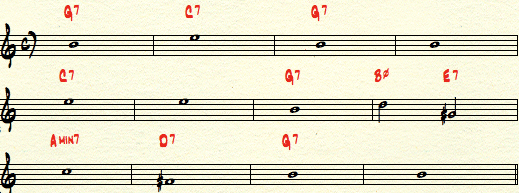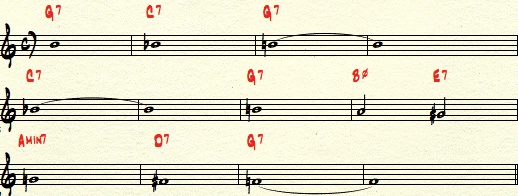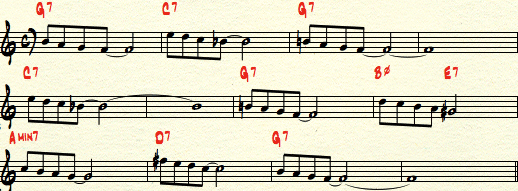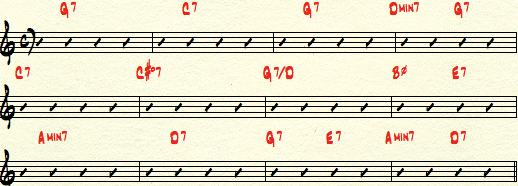Play what you’re hearing in your head! These are the instructions that numerous books, videos, and educators tell us as we struggle to figure out how to play over chord progressions. The only problem in situations like these is, as beginners, we aren’t hearing anything in our heads…
Think back to the first time that you tried to improvise a line over a chord progression. If you were anything like me, you were frantically looking for the “right” notes to play and using the one scale that you memorized to find them. When you are learning to improvise, you are too busy racking your brain for scales and avoiding “wrong” notes, to use your ears or hear anything.
Sure, it gets easier as you progress as an improviser: you learn many more scales, memorize chord progressions, transcribe solos, and figure out harmonic patterns. However, whether you like to admit it or not, with all of these tools that you pick up, you are still relying heavily on a mental knowledge of the music.
The bottom line here is that the majority of us aren’t using our ears nearly enough as we improvise. If you continually feel like improvising has become a repetitive exercise or that you keep returning to the same patterns and licks as you play over tunes, then this article is for you.
Confronting the gap between our ears and our minds
It’s a simple fact, it is much easier to understand a concept mentally than to actually execute it or perform it in front of an audience.
This statement is true of any profession, but it rings especially true for musicians. In the process of learning to improvise we pick up a lot of valuable information: melodic minor scales, pentatonic scales, ii-V lines, tri-tone subs. This is all good information, but it takes a lot more than mental understanding to have these concepts come out in your day-to-day improvising.
The problem with the majority of jazz education today is that it revolves around the idea of memorizing information (scales, chords, and lines), but the ability to actually hear it and sing it falls to the wayside. The result is that most of us understand much more theoretically about the music than we can actually perform.
It is helpful to understand jazz theory, memorize scales, and study chord progressions, but can you actually hear these concepts? Do you have them ingrained into your technique to the point that they’ll come out unconsciously in your improvising?
These are the factors that will make a drastic difference in your approach to playing jazz. When you can identify chord tones and progressions aurally and your technique is linked to your ears, you’ll be improvising on a whole new level.
Getting your ears up to speed
So how do you quickly improve your ears and begin to play what you hear?
First you must bring your ears to the same level as your mental understanding of the music. This process is going to be different for everyone. If you’ve spent time developing your ear in the practice room, then closing this gap won’t take as long. However, if you haven’t done any ear training at all, then you’re going to have to do a little homework.
Initially, it can be surprising how big the gap is between the level of your ears are your mental understanding of the music. You may be working on tri-tone substitutions or studying transcriptions that are highly chromatic in the practice room, but when it comes to your ears, you may still have trouble hearing and singing even the 3rds and 7ths of chords.
If this is the case for you, stick with it. You’ve already got a great start understanding the theory involved in improvisation, now you just have to get your ears to that same level. Make your ears a priority in your practice routine by doing some basic ear training exercises everyday.
Start with the blues
It’s important to remember that everything that we work on in the practice room is for the purpose of performing it over a tune. So as you work to improve your ears, why not apply it to a common chord progression like the blues?
Try this exercise: Aurally identify and sing the third of every chord of a basic 12 bar blues.
Now hold on for a second. I know what you’re thinking: “This is way too simple, I know by now that the 3rd of any chord is a strong chord tone.” Yes, you know in your mind, but could you sing the thirds of a blues progression if someone handed you a microphone? Instead of following the same pattern of mental practice – picturing the third of every chord in your mind and thinking about it for a second – you need to actually do this!
This means sitting down with a recording, identifying the unique sound of the 3rd with your ear, and then singing that note confidently over each chord. The only way to improve your ears is to actually use them in the practice room. If you continue to approach improvising in a mental fashion, the gap between your ears and mind is going to get wider and wider.
Now back to that exercise. Step one: find a recording of your favorite 12 bar blues. Locate a chorus of the tune where the progression is clear and loop it in Transcribe. Or, if you have the piano chops, you may even want to play the chords on the piano.
Next, isolate the sound of the 3rd of the chord and sing it over every chord in the progression. For a G blues, it would look like this:
If you’re having trouble getting the 3rd right away, try hearing it in relation to the root. Sing the root of the chord and then jump up a Major third to the 3rd of the chord:
The goal is to be able to confidently sing the 3rd of any chord in the blues progression without thinking about it. Practice this exercise until the sound of that chord tone is ingrained in your ears. Then, and only then, should you move to playing those same exercises on your instrument.
Once you have the 3rd of the chord down and you can confidently hear it, sing it, and play it over each chord of the blues progression, try the same exercise with the 7th of each chord:
Continue this exercise for every chord tone (root, 5th, 9th, 11th, 13th, etc.) so you can easily isolate the sound of any chord tone as you go to improvise.
Singing guide tone lines
One thing that jazz educators stress to beginning improvisors is to “play the guide tone lines” and “use 7-3 resolutions,” this way you’ll hear the changes. Playing guide tone lines on our instruments is a good way to see the inter-workings of a chord progression, but is by no means a guarantee that we’ll be able to hear that progression.
In fact, playing guide tone lines can quickly become a mental exercise; we know the 7th of one chord can resolve to the 3rd of another and vice-versa. As a result, we use this mental formula to navigate chord changes, picturing the notes in our mind and figuring out how to resolve them to the next one. Pretty soon our ears are left out all together and the original goal of “hearing” the changes is ironically missed.
To get the most out of guide to lines, you have to hear them and sing them first – before you even touch your instrument.
Let’s go back to that blues in G. Try singing this guide tone line below that starts on the 3rd (Remember for each example, play the chords at the piano or sing along with a recording):
Using the same idea of 7-3 resolutions shown above, create a guide tone line starting on the 7th:
Create your own patterns
After you’ve got the sound of the 3rd and the 7th of each chord and the resolutions inherent within a blues progression in your ears, it’s time to develop some of your own patterns over this progression.
Here’s an example, going from the 3rd down to the 7th of each chord:
When you become comfortable with this, explore using alternate progressions for the blues or even substituting chords:
As you can see, it can keep getting more and more complex. The key is that you are singing everything and forging that crucial connection between your ears and your technique. Now, after trying some of these exercises, when you listen to a blues progression, you should automatically start hearing ideas in your head to play.
Eventually, as you go to improvise, you won’t be stuck with one scale or lick to work with – you’ll actually be hearing chord tones, guide tones, and musical ideas in your head. Follow this same practice technique for any tune that you may be working on. Even though these exercises look elementary at first glance, they truly are the formula for playing what you hear.

















